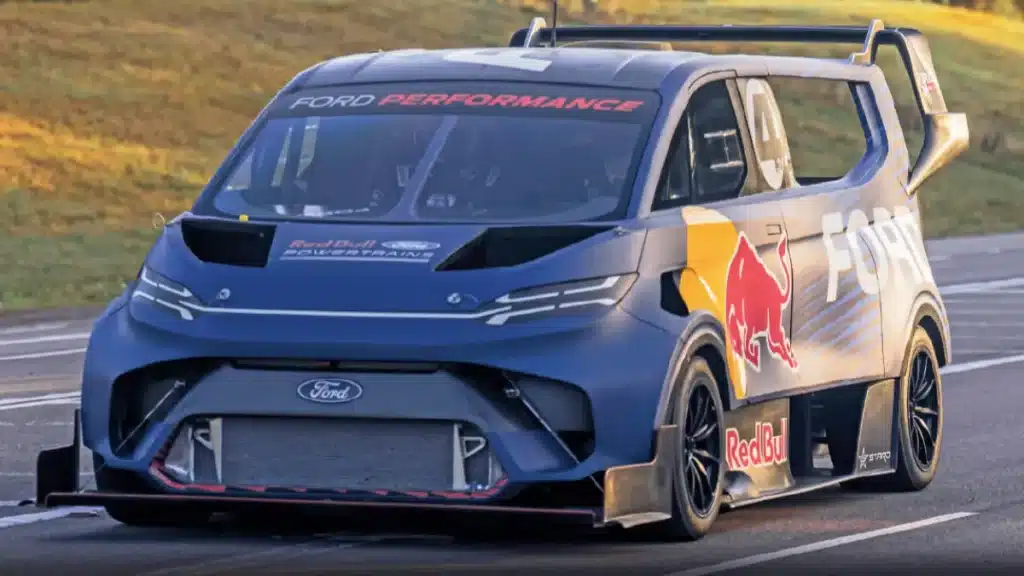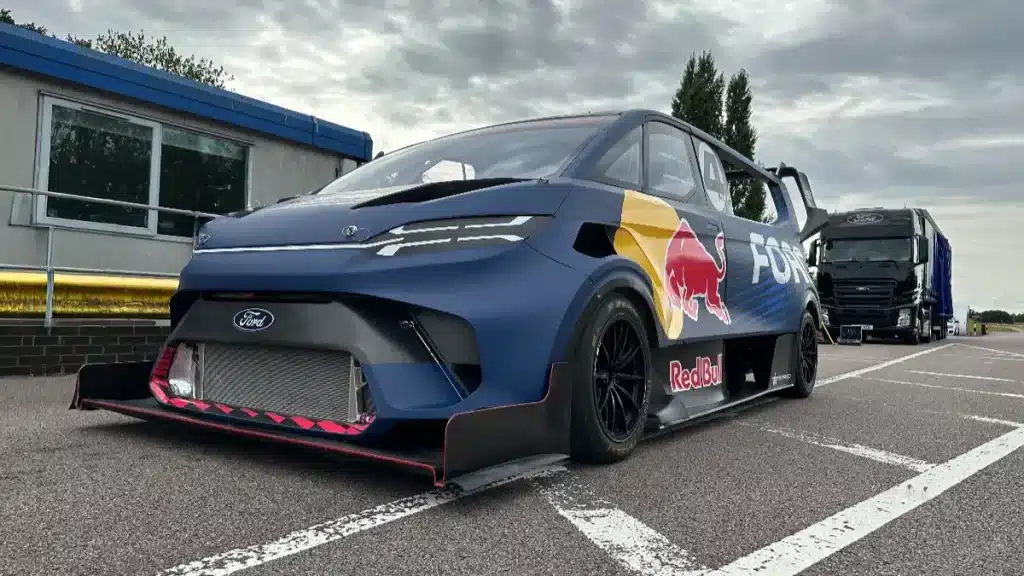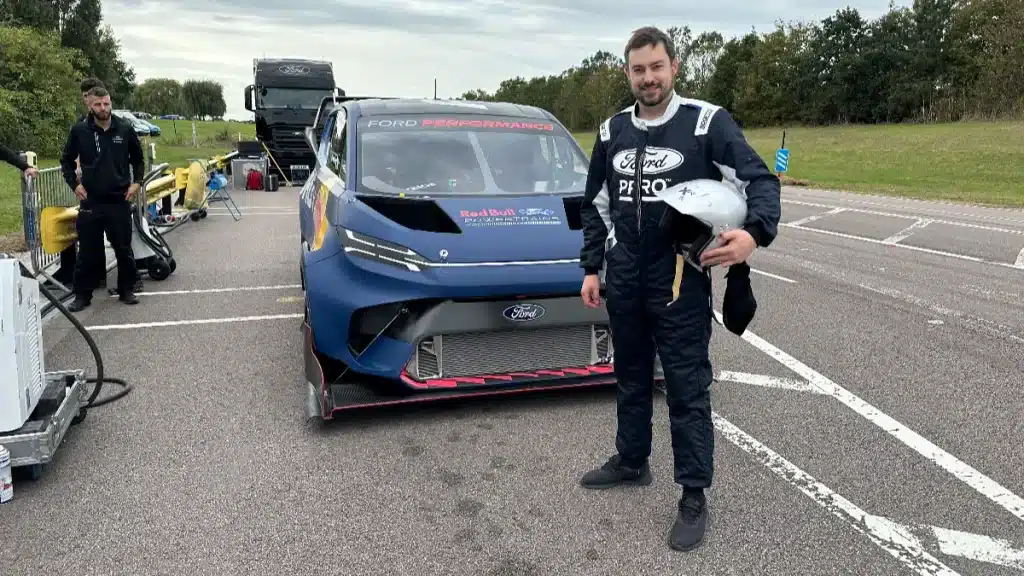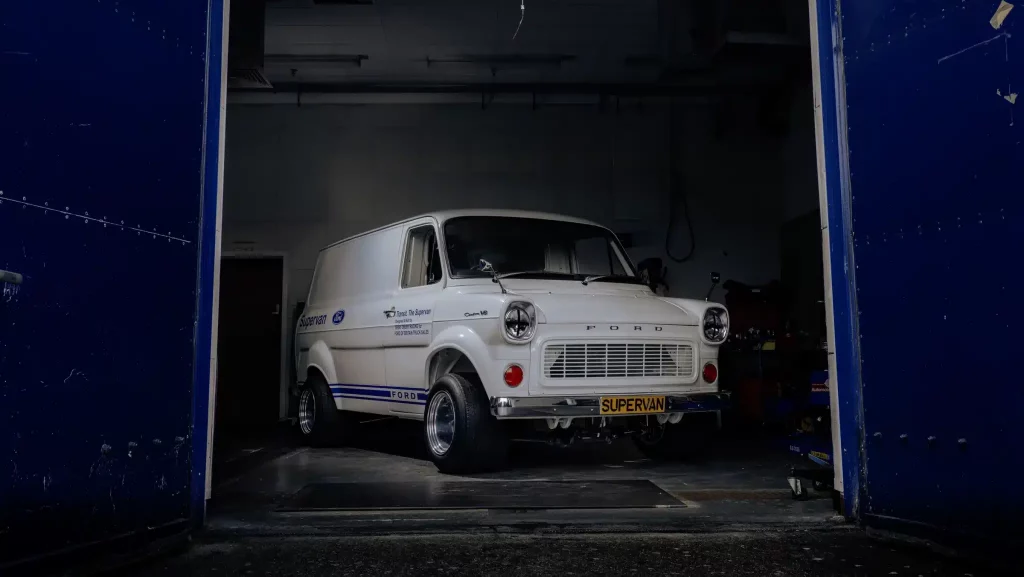
It’s not often you’ll hear that something has been given less power to make it go faster, but that’s exactly what Ford has done to its SuperVan 4.2 but even with 600hp less it’s still the most intense performance vehicle you’re likely to experience.
My passenger ride in the SuperVan might have been brief (less than a minute) but that’s hardly surprising given that it has 1400hp, a top speed of 185mph and can hit 100mph in just 2.2 seconds. It certainly doesn’t hang about.
It’s the latest in a long line of specially modified Transit vans dating back to 1971 when the first SuperVan was launched with a V8 engine from a GT40. This latest iteration, however, is all-electric and as the name might suggest it’s also a tweaked version of the 2000hp SuperVan first unveiled at Goodwood Festival of Speed in the summer.
The first all-electric SuperVan, SuperVan 4, was the most powerful SuperVan to date.
It had a staggering 2000hp from four electric motors, using parts from the upcoming Ford E-Transit Custom. It was also a fully connected van, using the Ford Pro tool kit to give real-time data from the SuperVan for analysis by fleet managers or would-be race directors.
The four electric motors, one in each wheel, are powered by a 50kWh liquid-cooled battery with a bespoke control system. It also has a purpose-built, track-ready chassis with a steel spaceframe and lightweight composite body panels.

Under the skin there is unequal-length double wishbone suspension at each corner with motorsport-grade front and rear subframes, uprights, and brakes. Unusually for an electric van, it has a two-speed gearbox with a very short first ratio to ensure maximum gearing to get the best possible acceleration.
As it is a connected van, the SuperVan 4 also had a host of onboard cameras to broadcast the action to its audience, with the driver also able to pull camera feeds into the on-board Sync 4 screen which is a carry-over from the E-Transit.
The interior has a full roll cage as well as FIA approved racing seats, while the screen allows you to select between five tailored drive modes that alter the SuperVan’s torque maps and regenerative braking. There’s even a loadspace, of sorts, with a side door for loading and unloading.
Keeping the first SuperVan 4 attached to the ground was a substantial aero package with a large wing rear diffuser, front splitter and side skirts, but changes to SuperVan 4.2 took downforce to a new level.
Built by Ford Performance and motorsport experts STARD, the SuperVan’s cutaways and dorsal fin help to push air onto the rear wing. This generates downforce and keeps the electric SuperVan on the track, but SuperVan 4.2 was redesigned to take on a much greater challenge than a mere racetrack – the 156 corners of the infamous Pikes Peak hill climb in Colorado.

Finishing at 14,115ft above sea level, SuperVan 4.2 needed to be able to deal with the thinner air at the top of the Pikes Peak mountain. That meant a much larger rear wing, as well as a significant diet to improve its power to weight ratio.
A new lightweight carbon-fibre rear spoiler and front splitter were added, and perhaps counterintuitively for a vehicle set to compete in one of motorsport’s most demanding races, one of the front motors was removed, cutting the overall power to 1050kW. The net result though is 1996kg of downforce at 150mph.
The brake regeneration system has also been revised, along with the driveshafts. Taking weight saving to the extremes, the SuperVan 4.2 also gets the fanciest set of alloys you’re ever likely to see on a van, with magnesium-forged wheels and Pirelli P Zero racing tyres.
The glass windscreen is replaced by Perspex and as I clambered over the side impact bar of the roll cage it was became obvious that absolutely everything unnecessary has been stripped out from the interior.

Electric vans are normally quiet on start-up, but there’s a sort of eery hum to the SuperVan which gives way to a rumble and then whine as the thing starts to move. You’ll appreciate that I’ve not been in a spaceship before, but the cry of the motors as they spin is quite otherworldly, and then the full force of that 1400hp hits.
I’m slingshotted to probably around 80mph before the driver throws in a perfect handbrake turn, rotating the van on its front axis like a skier putting in a huge carve turn down a mountain.
We whip around to face the full length of the runway and without pause the SuperVan is rocketing – and I really mean rocketing – forward.
The noises get even weirder and louder too. A quiet EV, the SuperVan is not. But it’s soon hitting close to its top speed in what could only have been barely less than 8 seconds of acceleration before it’s on to the brakes and back down to a walking speed as my body slams into the race harness and the wide grins of both my driver and I touch our respective ear lobes.

Another perfect turn on a six-pence and we’re heading back the other way with just as much force. The power is brutal but having been in many fast-engined cars before the SuperVan feels very different.
Perhaps there being relatively little theatre involved, without the booming sounds of combustion, it seems somehow refined.
The whole experience also seems a shade improbably. Almost Playstation-like. Vans simply aren’t meant to do this. There’s also an unnerving amount of stability, while accelerating and under braking. I can only begin to imagine what this thing would have been like at maximum attack up a mountain road.
There’s no denying that it is a super van in every aspect. I only wish I was the one driving.

While SuperVan 4 might have been something of a marketing ploy to promote Ford Pro and drum up interest in the forthcoming E-Transit Custom, SuperVan 4.2 is a single-minded weapon hell-bent on capturing a win in the Open class at Pikes Peak.
The 12.4 miles of twisting mountain road were tackled by Pikes Peak Pro (try saying that after a drink) Romain Dumas who not only took the SuperVan 4.2 to a class win at the 2023 race, but also to second in the overall competition, narrowly missing out on first by just 7.6 seconds with an overall time of 8 minutes 47.6 seconds.
Dumas and SuperVan 4.2 did, however, shatter the previous Open class record of 9 minutes 24 seconds.

Based on the Transit Mk1, Ford’s first SuperVan (above) was created in 1971 with a mid-mounted 4-litre V8 engine from the Le Mans-winning Ford GT40.
SuperVan 2 arrived in 1984 with a Cosworth V8 producing 590hp in a Transit Mk2 body.
A facelifted Transit Mk3 became SuperVan 3 with an even more powerful 3-litre 650hp Cosworth engine which at the time was being used to power F1 cars.